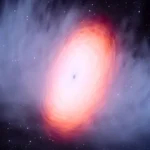Key Points:
- The asteroid that caused the dinosaur extinction 66 million years ago originated beyond Jupiter.
- Geochemical evidence from the Chicxulub impact site supports the origin of this outer solar system.
- The study rules out the comet hypothesis, suggesting the impactor was a carbonaceous asteroid.
- The findings highlight significant events in the asteroid belt that may have increased Earth collisions.
New geochemical evidence from the Chicxulub impact site in Mexico suggests that an asteroid that originally formed beyond Jupiter’s orbit caused the catastrophic event that led to the extinction of nearly all dinosaurs 66 million years ago. The findings, published on August 15 in Science, suggest that this mass extinction event was triggered by a sequence of cosmic events that began with the formation of the Solar System.
For decades, scientists have suspected that the Chicxulub impactor—a massive object that struck Earth near Mexico’s Yucatán Peninsula—originated from the Solar System’s outer regions. The new research provides robust evidence supporting this theory, showing that the asteroid likely came from a region beyond Jupiter, where volatile-rich, carbonaceous asteroids formed.
The Cretaceous-Paleogene (K/Pg) extinction, which wiped out over 60% of species on Earth, including all non-avian dinosaurs, was the fifth and most recent mass extinction in Earth’s history. The event has long been linked to a city-sized object colliding with Earth, causing massive amounts of sulfur, dust, and soot to be ejected into the atmosphere. This led to a global cooling effect by blocking sunlight, drastically altering the climate and ecosystems.
To determine the origin of the Chicxulub impactor, Mario Fischer-Gödde, an isotope geochemist at the University of Cologne, and his team analyzed rocks from the K/Pg boundary at three different sites. They compared the isotopic signatures of ruthenium—a rare metal on Earth but more common in asteroids—with those from eight other impact sites dating back 3.5 billion years. Ruthenium isotopes are particularly useful in distinguishing between asteroids that formed in the inner and outer Solar systems.
The study found that the isotopic composition of ruthenium in the Chicxulub impactor closely matched that of carbonaceous asteroids from the outer Solar System rather than the silicate-rich asteroids that formed closer to the Sun. This evidence also effectively rules out the hypothesis that the impactor was a comet, a theory proposed in various studies, including a controversial 2021 paper.
Sean Gulick, a geophysicist at the University of Texas at Austin, praised the study’s methodology, noting that it offers a clear and consistent answer to the impactor’s origin. The research also indicates that the Chicxulub asteroid likely came from the main asteroid belt between Mars and Jupiter, a region where sizeable carbonaceous asteroids are more common than comets.
Interestingly, the study also found that most other impactors from the past 3.5 billion years originated in the inner Solar System, except some of the oldest impactors, which share similarities with the Chicxulub asteroid. This suggests that significant events, such as the breakup of large asteroids, may have occurred in the asteroid belt, increasing the likelihood of such objects colliding with Earth.












